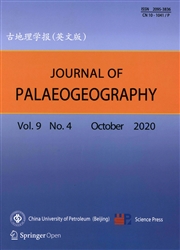Oxygenation in carbonate microbialites and associated facies after the end-Permian mass extinction:Problems and potential solutions
作者:Stephen Kershaw,Hao Tang,Yue Li,Li Guo
摘要:Carbonate sediments deposited in normally-oxygenated shallow ocean waters of the latest Permian period, immediately prior to the end-Permian mass extinction, contain well-developed diverse shelly faunas. After the extinction of these skeletal metazoans, the sediments commonly comprise microbialites(regarded by most authors as benthic) and associated facies bearing evidence interpreted by many authors to indicate reduced oxygenation of the shallow ocean waters. However, the evidence of oxygenation state is inconsistent and the sequences have gaps, indicated in the following 5 points:1) Shelly fossils occur commonly in post-extinction shallow marine limestones, and likely to have been aerated in contact with the atmosphere. Nevertheless, although the largest mass extinction in Earth history may have caused reduced body size in shelly organisms, such reduction is arguably due to environmental stress of lowered oxygenation. Discriminating between these controls remains a challenge.2) Abundant pyrite framboids in many post-extinction limestones are interpreted by several authors as indicating dysoxic contemporaneous waters, so the organisms that lived there, now shelly fossils, were dysaerobic. However, verification is problematic because pyrite framboids scattered amongst shelly fossils cannot have formed amongst living organisms, which need at least some oxygen; synsedimentary framboid formation requires anoxic conditions in the redox boundary where sulphate-reducing processes work. Thus, framboids and shelly fossils found together means taphonomic mixing of sediments, destroying original depositional relationships so that it is not possible to determine whether the shells were aerobic or dysaerobic prior to sediment mixing. Furthermore, diagenetic growth of framboids is possible, as is import of previously-formed framboids from deeper water during upwelling. Thus, there is no proof of an environmental link between framboid size and occurrence, and contemporaneous oxygenation in these post-extinction shallow water f
发文机构:Department of Life Sciences State Key Laboratory of Oil and Gas Reservoir Geology and Exploitation CAS Key Laboratory of Economic Stratigraphy and Palaeogeography CASP
关键词:STROMATOLITEThromboliteMICROBIALITEPERMIAN-TRIASSICboundaryPyriteANOXIA
分类号: P[天文地球]
- Genus Pronephrium Presl 1851 (Thelypteridaceae) in Romania
- Ancient rip current records and their implications: an example from the Cretaceous Ukra Member, Kutch, India
- New freshwater plesiosaurian materials from the Middle Jurassic Xintiangou Formation of the Sichuan Basin, southwestern China
- First steps in reconstructing Early Jurassic sea water temperatures in the Andean Basin of northern Chile based on stable isotope analyses of oyster and brachiopod shells
- A facies and palaeogeography-based approach for analysis of petroleum systems in United Arab Emirates
- The complexity of climate reconstructions using the coexistence approach on Qinghai-Tibetan Plateau
- The use of mineral interfaces in sand-sized volcanic rock fragments to infer mechanical durability
- Fruits of Scirpus (Cyperaceae) from the early Miocene of Weichang,Hebei Province, North China and their palaeoecological and palaeobiogeographical implications
- Words of the Editor-in-Chief——some ideas about the comments and discussions of hyperpycnal flows and hyperpycnites
- Summary of Editorial Committee Meeting (January 5, 2020) of Journal of Palaeogeography


